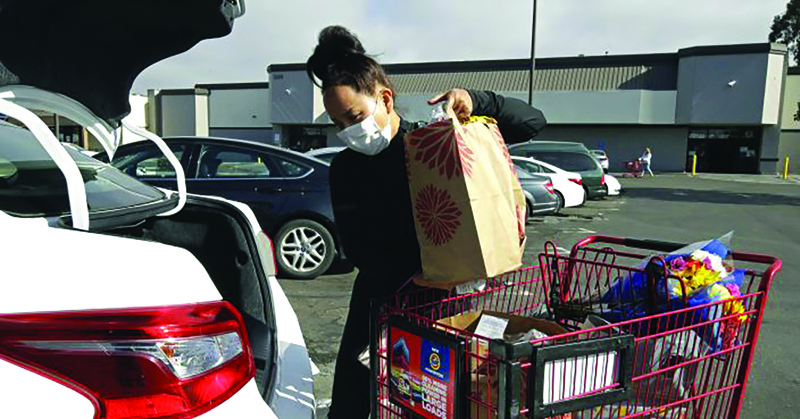
WASHINGTON: Tyrita Franklin-Corbett knew she was risking her health delivering groceries during the coronavirus pandemic, but she didn't expect to be laid up by a dog attack. Furloughed from her job as an auditor at a public accounting firm in May, the single mother of a 12-year-old son from Upper Marlboro, Maryland, started to take on more shifts with online grocery pick-up and delivery service Instacart.
Franklin-Corbett, 45, had been an Instacart "shopper" for several years to supplement her salary, but she never imagined the app-based work, with its wild swings in earnings and no health insurance or sick pay, being her sole source of income. "It's a gig, not a career," Franklin-Corbett told the Thomson Reuters Foundation. "When I was in the office, I knew what my paycheck was going to be every day. With this, you do not know. There's a lot of unknowns, a lot of uncertainty. "You don't know if you're going to have to carry four cases of water up three flights of steps. You don't know how much traffic you have to sit in if you want to make 40 bucks."
Aside from carting heavy groceries and risking exposure to the coronavirus, Franklin-Corbett was bitten on the foot by a customer's dog in March. "It was horrific," said Franklin-Corbett, who had to stop work for two weeks, getting $60 compensation from San Francisco-based Instacart and $1,600 from the customer's insurance plan. But with the pandemic sending unemployment to highs not seen since the 1930s Great Depression, more people are joining the growing U.S. army of gig workers, competing for jobs they say pay less and less while trying to avoid contracting COVID-19.
Gig workers are independent contractors who perform on-demand services, including as drivers, delivering groceries or providing childcare - and are one-third more likely to be Black or Latino, according to a 2018 Edison Research poll. The US Bureau of Labor Statistics reported in 2017 that 55 million people in the United States were gig workers - or 34 percent of the workforce - and this was projected to rise to 43 percent in 2020.
Of these about 1.6 million are part of a growing group of workers to emerge in the past decade, paid by tech platforms like ride-hailing giants Uber and Lyft or food delivery apps like DoorDash and Postmates. In the past 12 months alone, two million Americans have started freelancing, according to a September study from Upwork, a freelance job platform.
This ongoing shift in the workforce and calls for greater protection for gig workers has put the issue on the political agenda ahead of the Nov. 3 election, with California voters to decide on a landmark state law ruling such workers as employees. For while some companies and workers praise the flexibility of gig work for juggling families and multiple jobs, some labor activists fear an economic slump will leave gig workers in dire straits with no safeguards like minimum wage or health cover.
'Felt like a free fall'
Gig workers were included when the US government introduced a $2.3 trillion coronavirus relief bill in March. The bill included payments of up to $1,200 each to millions of Americans, increased and extended unemployment benefits for workers including contractors, and small business loans. But after the initial round of pandemic-related aid dried up in August, job growth has slowed more than expected with COVID-19 cases rising and the number of deaths nearing 220,000.
Lawmakers remain in a deadlock on further aid ahead of next month's election, adding further uncertainty to an already weak US economic recovery in which many companies and workers initially facing job furloughs are now permanently laid off. In September the number of unemployed people in the United States was 12.6 million compared to 5.7 million a year earlier, with an overall jobless rate of 7.9 percent but higher numbers among teenagers, Blacks and Hispanics, according to government data. One of those laid off was Serenety Hanley, whose career in digital communications included a stint in the White House under President George W. Bush.
The 45-year-old single mother was let go from a retail job in March and now makes a living by shopping for Instacart, whose orders jumped fivefold during the pandemic as consumers grew wary of venturing out to stores. Living off money she makes lugging groceries and dipping into a college savings account set aside for her 11-year-old son, Hanley said she still can barely make ends meet. "It felt like a free fall," said Hanley, who lives in Arlington, Virginia. "(But) even though I'm not getting the same benefits as a white-collar job, I do appreciate that I have an opportunity to make money at all."
Fell through the cracks
Getting government help has proved difficult. After the relief bill was passed, many state authorities were overwhelmed by applications for unemployment pay, with a record 10 million Americans filing for assistance in late March and April, and many gig workers fell through the cracks. Franklin-Corbett said she received her federal stimulus check but, despite calling Maryland state offices regularly, she has not gotten the additional unemployment benefits she is due.
She was also concerned that the delivery business during the pandemic had attracted a flood of new workers who lost other jobs so the pay was no longer as good. Instacart said this month that it had brought on 300,000 new "shoppers," more than doubling its workforce to 500,000. Prior to the pandemic, Franklin-Corbett said she could make up to $300 in a few hours. On a recent trip that took more than an hour and a half, she made $9. "I have to work twice as much to make half of what I was making to survive," she said. - Reuters




